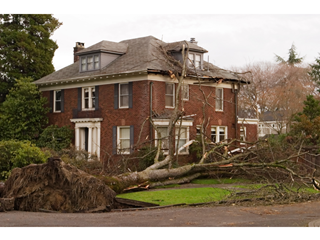
Insurers blame storms and subsidence for the higher cost of home insurance premiums.
The average cost of a combined home insurance policy rose to £396 in the second quarter (April to June) of 2024, according to the latest figures from the Association of British Insurers (ABI).
This is an increase of £21 from the previous quarter and is 19% higher than one year ago when the average cost of a premium stood at £329.
Home insurance is just one of the costs that has been squeezing the finances of homeowners over the past couple of years, alongside food, fuel and car insurance, for example, so news of this latest increase will be disappointing but is likely to come as little surprise.
When looking at buildings-only insurance, the average cost rose £23 from the previous quarter to £321.
Meanwhile, the average cost of contents-only insurance saw a smaller rise of £5 to reach £137 in the second quarter of 2024.
Home insurance is an umbrella term for buildings insurance, which covers the main structure of your home, and contents insurance, which covers the items inside. This insurance can provide cover in the event of fire, flooding, storm damage, subsidence and theft, for example.
A major reason why home insurance costs are going up is because insurers are facing higher costs.
Insurers paid out £1.4 billion to homeowners and business in property insurance claims during the second quarter of 2024, the highest amount paid in a single quarter since records began in 2017.
The average payout per insurance claim also rose 16% between the first and second quarter of 2024 to £5,284.
Recent bad weather is said to be a major factor behind the increase in costs, as property owners had to cope with damage caused by storms, heavy rain and frozen pipes, for example.
Insurers paid out £144 million in weather-related claims in the second quarter of 2024, which was the fifth consecutive quarter this figure has been over £100 million.
Subsidence was another significant issue, with insurers paying out £60 million between April and June. This was the highest quarterly figure for subsidence-related claims on record and is up from the £53 million that insurers paid out in the first quarter of 2024.
Read more: Does home insurance cover storm damage?
Even if you haven’t made a claim in the past year and your situation remains the same, you may find that the cost of your home insurance has increased.
While there’s not a lot you can do about the price-setting strategies of insurers, there are ways you may be able to find a better deal for your cover.
Firstly, when it’s time to buy or renew a home insurance policy, don’t automatically renew with your existing insurer. It’s worth comparing policies from other providers to see if they can offer the same level of cover for a better price.
As well as comparing policies, you may also be able to cut the cost of your home insurance by:
It’s also important to make sure your policy accurately reflects the value of your home and its contents as overestimating these figures means you are likely to pay more for your insurance than necessary.
On the other hand, while underestimating the value of your property could be a tempting way to try to cut the cost of your insurance, you should avoid doing this as it means you may not receive full compensation for your loss if you need to make a claim.
Find the right level of cover for you by comparing home insurance policies.
Information is correct as of the date of publication (shown at the top of this article). Any products featured may be withdrawn by their provider or changed at any time. Links to third parties on this page are paid for by the third party. You can find out more about the individual products by visiting their site. Moneyfactscompare.co.uk will receive a small payment if you use their services after you click through to their site. All information is subject to change without notice. Please check all terms before making any decisions. This information is intended solely to provide guidance and is not financial advice. Moneyfacts will not be liable for any loss arising from your use or reliance on this information. If you are in any doubt, Moneyfacts recommends you obtain independent financial advice.